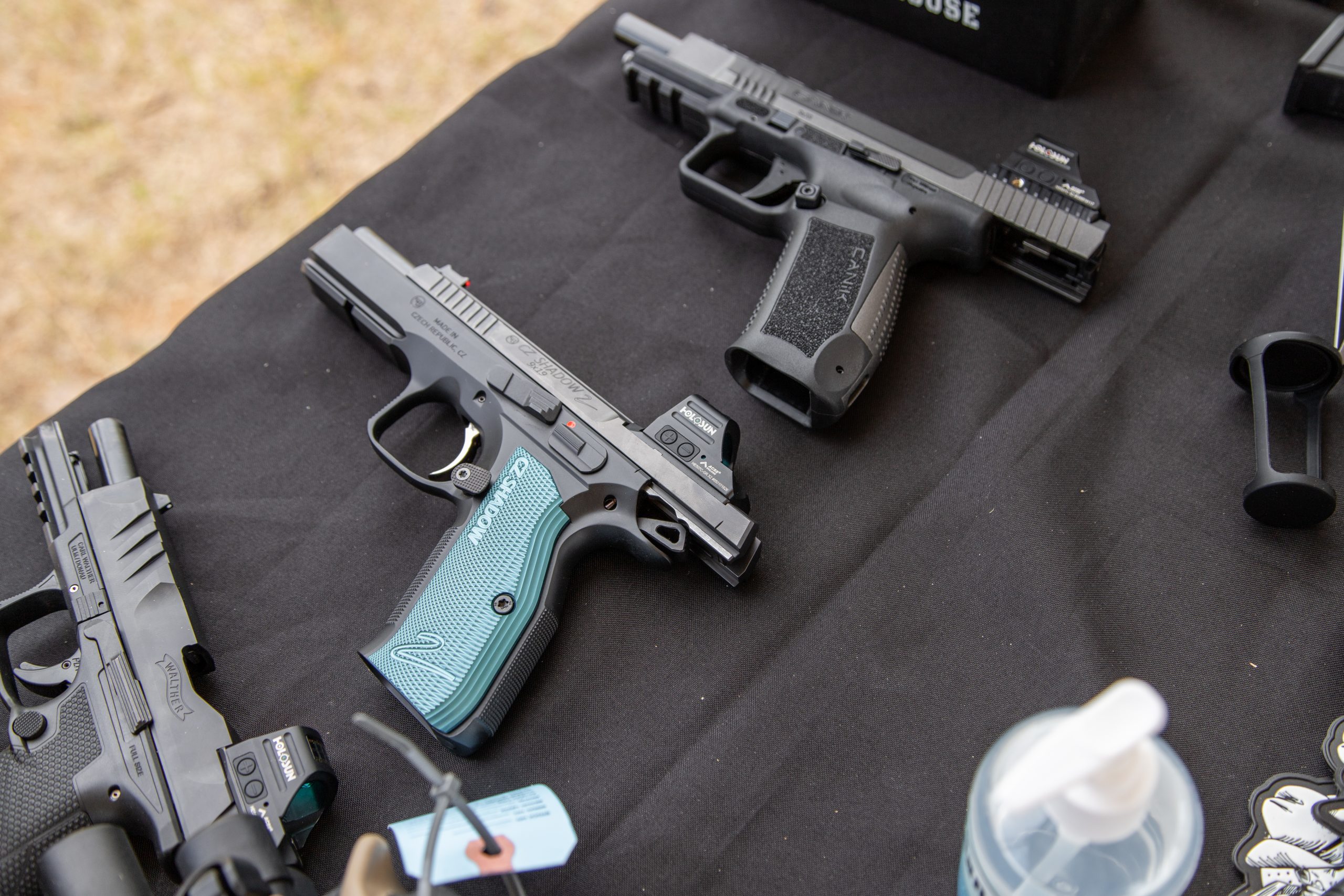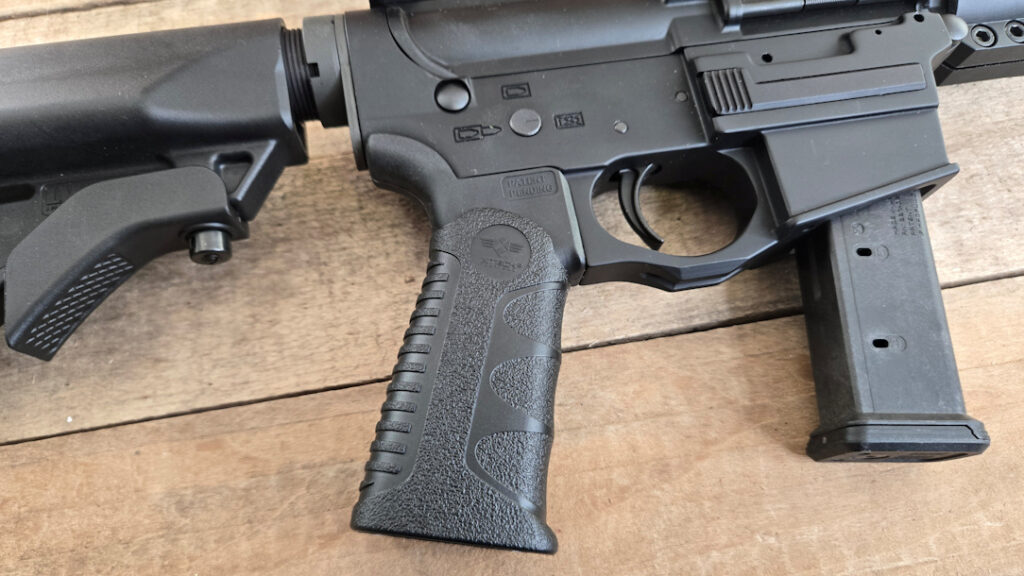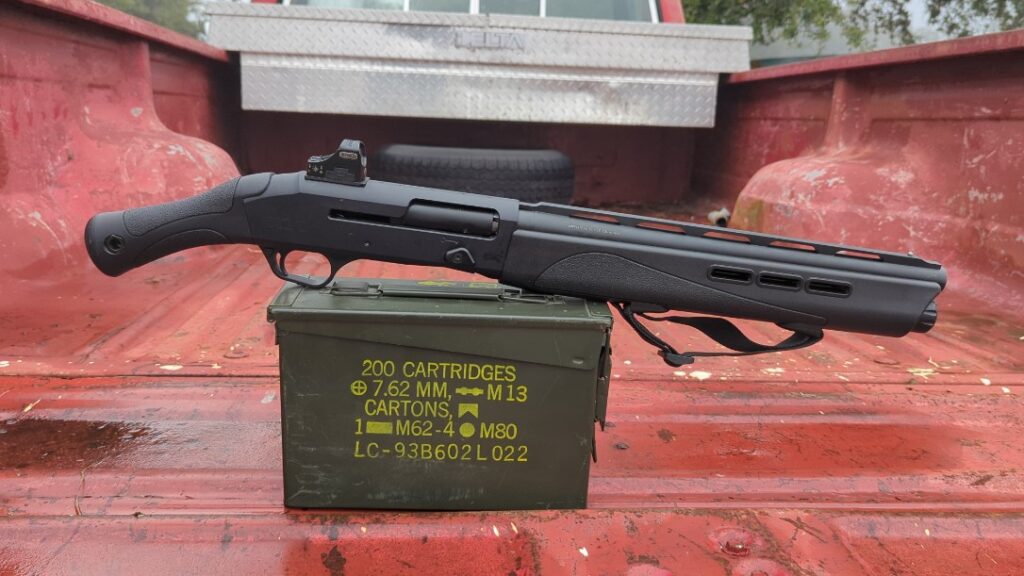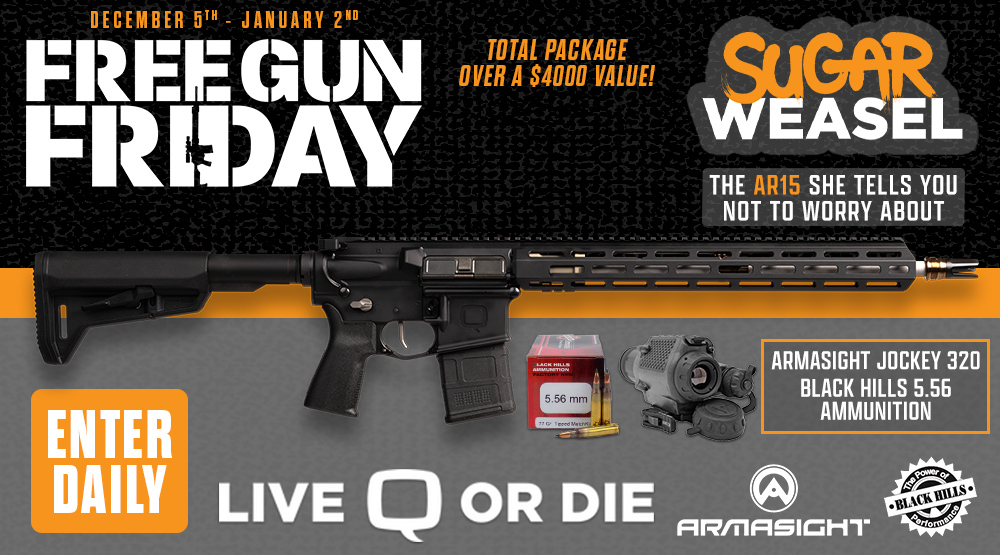3-gun competition is an intimidating sport to get started in. Three different firearms, dozens of magazines, pouches, shell caddies: Trying to pick the best piece of equipment for every category can get overwhelming fast.
Trying to find the right handgun is often the most difficult piece of the puzzle; everyone more or less agrees on an AR for the rifle portion, and your choice of shotgun is unlikely to make-or-break your match, but it’s hard to recover from a poor performance with your 3-gun pistol. For that reason, it’s important to find one that’s not just a good fit for the sport, but also for you.
Luckily, at least in America, there is a large variety of firearms stores both brick and mortar and online, so once you actually decide what you want, it will be easy to find one for sale.
Advertisement — Continue Reading Below
What Makes a Good 3-Gun Pistol?
The ideal 3-gun pistol is basically the antithesis of the ideal carry pistol; instead of small, lightweight, and easy to conceal, you want big, relatively heavy, and easy to run fast. A good 3-gun pistol should have a full-size frame, providing maximum surface area for grip. A full-size frame means full-size magazines as well, which can be the difference between reloading once during a stage or reloading twice or more. Fewer reloads mean less time spent on the stage, and that’s what 3-gun is all about.
Another consideration is sight radius. Sight radius is essentially the distance between your front and rear sight. A longer sight radius typically translates into more precise aiming; the greater the distance between your sights, the more visible misalignment will be, making it easier to line up a perfect shot. Since a lot of 3-gun divisions prohibit red dot optics on pistols, a longer sight radius can be an advantage, especially on stages that require highly precise or long-distance shots.
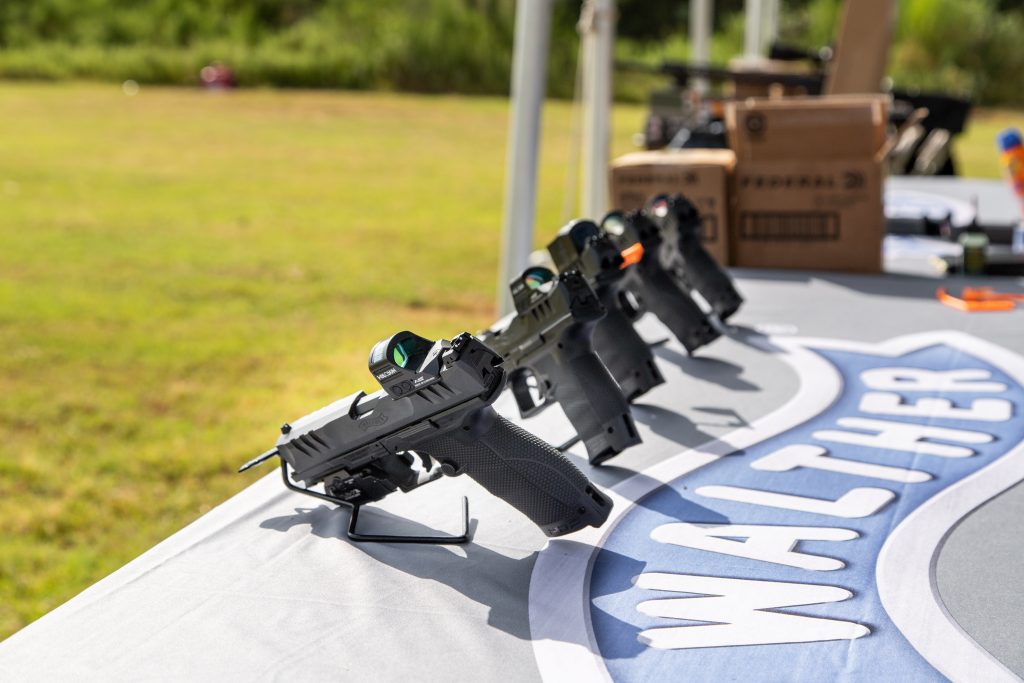
Advertisement — Continue Reading Below
3-gun competitions are all about speed, and so a big consideration in a good 3-Gun pistol is recoil impulse. The less your muzzle is flipping with every shot, the faster you can reacquire your sights and get back on target. For this reason, some competitors opt for heavier guns with big steel frames; all that weight soaks up the recoil, letting them focus more on their sights and trigger press and less on recoil control.
However, heavier guns can often be slower out of the holster and to transition between targets, especially for newer competitors who are used to shooting polymer-framed guns. Ultimately, the balance between weight and recoil comes down to personal preference; there are world-class shooters on both sides of the issue.
Another consideration, albeit a less important one, is aftermarket support. As new competitors transition into seasoned ones, it’s common for them to find things about their firearms and equipment that could be improved. When this happens, it’s convenient for there to be an aftermarket that offers solutions.
Advertisement — Continue Reading Below
Not loving the grip on your Glock? There are hundreds of stipplers all over the country that can alter the shape or texture. On the other hand, if you’re running a CZ, your options are basically to change out the grip panels or learn to live with it. The same goes for triggers, sights, safeties, etc.
Of course, there are a million little factors that go into this decision, and they’re not the same for everyone. Some shooters want specific sights, or a particular trigger feel. The above-mentioned are the biggest consideration though, so now let’s take a look at some of the best 3-gun pistols on the market.
Is The Glock 34 The Best Pistol For 3-Gun?
Of course, there was going to be a Glock. It’s impossible to talk about the best pistol for anything without Glock being in the conversation. Glock made their name as the go-to pistol for law enforcement and concealed carry, but they occupy a sizable space in the competition market as well. Renowned for their unyielding reliability and supported by what is probably the largest aftermarket in the industry, it’s hard to go wrong with a Glock.
Advertisement — Continue Reading Below
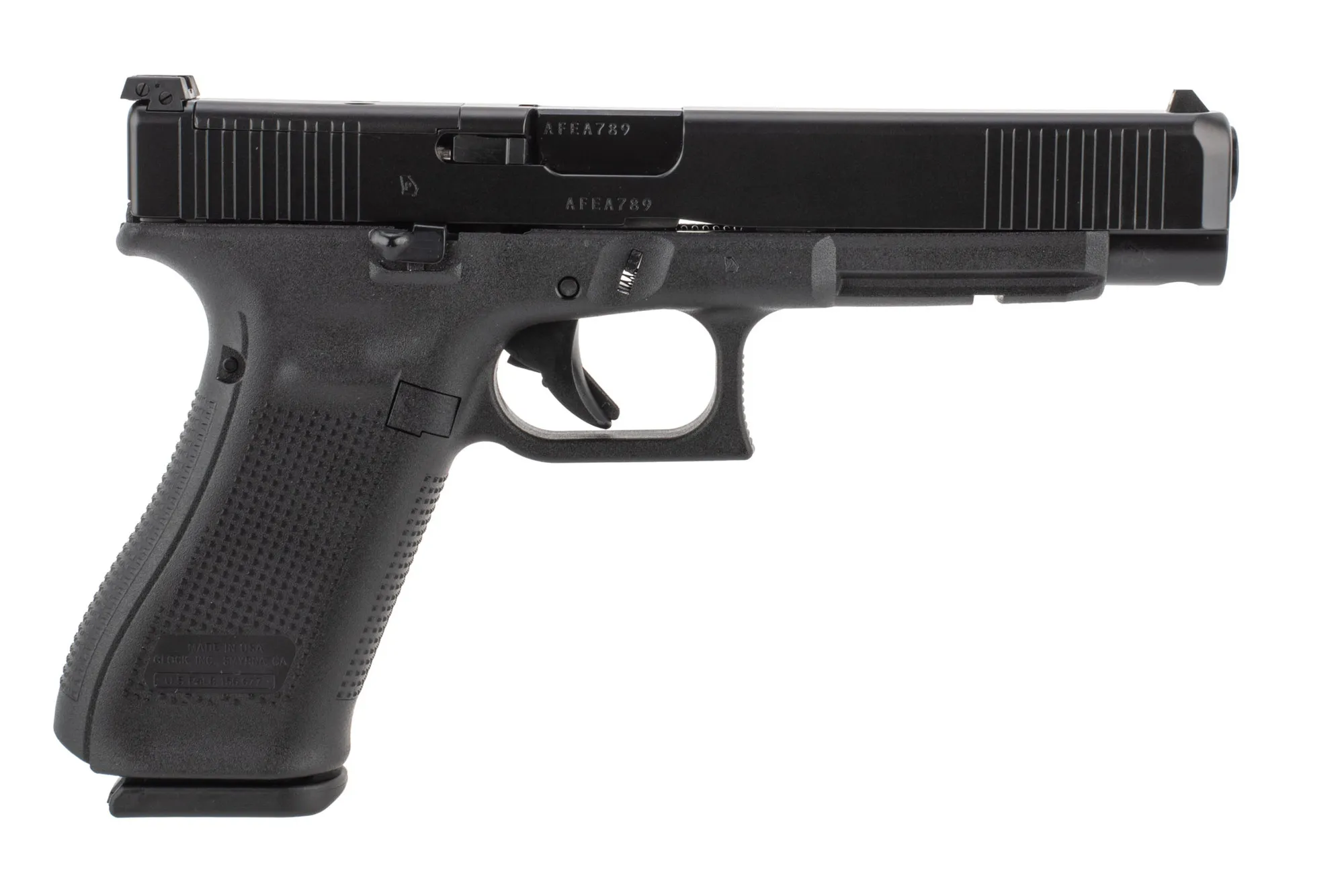
For 3-gun, we’re partial to the Glock 34. Unlike other shooting sports, most 3-gun competitions don’t have a power factor, so it makes sense to go with 9mm for minimal recoil and maximum capacity. It shares the same frame as the venerable Glock 17, offering a full-size grip with or without finger grooves, depending on which generation you select.
The 5.31″ barrel will wring every last bit of velocity from your ammo, which might not sound important for a competition, but you’ll be glad for it the first time you come up against a stubborn steel popper target. The extended slide and barrel also stretch out the sight radius.
Advertisement — Continue Reading Below
That said, it’s hardly the perfect competition gun right out of the box. As a polymer-framed gun, the Glock 34 is a fair bit lighter than other competition pistols. This means less fatigue on the user’s arms, especially during long matches, but it also means more muzzle flip. While the Glock 34’s recoil is certainly manageable, many heavier competition guns do shoot flatter.
The Glock 34’s 5-pound trigger is appropriate for carry but less than optimal for competition. The basic plastic sights also leave a lot to be desired, and many shooters find the boxy grip and thick trigger guard unpleasant. Luckily, there is a remedy for that.
Glock pistols come with aftermarket support the likes of which other guns can only dream of. There are remedies aplenty for each of the issues mentioned above if you’re willing to fork out the cash for them.
Advertisement — Continue Reading Below
The Glock 34 is one of the more economical pistols for 3-Gun, with a street price of around $700. However, once you start upgrading, it’s easy to spend that much again on triggers, sights, and frame work, not to mention extended magazine catches, match-grade barrels, etc.
By the time you finish customizing your Glock 34, you may find that for the same amount of money, you could have bought a much more expensive pistol.
There are certain advantages to going the Glock route, though. Starting with a stock Glock allows you to get into the sport immediately, rather than saving up cash for a high-dollar gun. Competing with an out-of-the-box Glock will help you to get a feel for the gun, the sport, and your shooting style before laying out too much money.
Advertisement — Continue Reading Below
After some experience, you can begin customizing your pistol piece by piece, investing where it will count without wasting any money on upgrades you didn’t need. This can be a great option for those looking to save a few bucks while still having a capable pistol.
Alternatively, if you’re sure you know exactly what you’re looking for, there are plenty of custom gunsmiths out there that will rebuild a Glock from the ground up. This gives you a great deal of control over the final product, allowing you to dictate nearly every aspect of the pistol. A custom Glock build will cost a pretty penny though, especially from a prestigious builder.
But the aftermarket isn’t just limited to triggers and sights. Part of what makes the Glock 34 such an economical choice is the vast array of support gear. Nearly every holster manufacturer in existence supports Glock pistols, making it easy to find a decent competition holster for $50, sometimes less. The same goes for magazines; Magpul extended models start at under $20. The same capacity magazine for a 2011 can cost $100 or more.
Advertisement — Continue Reading Below
In sum, the Glock 34 is a great option for an up-and-coming competitor looking to get into the sport without laying out too much cash, or an experienced one looking for ultimate customization. A vast aftermarket provides both cheap accessories and every upgrade you could ever need. Before buying, though, it’s worth considering the total amount you plan to spend, and whether one of our other recommendations may meet your needs better.
The CZ Shadow 2 Is A Great Contender
CZ’s popular Shadow 2 pistol is widely considered to be one of the best values in competition shooting. It’s especially popular in USPSA production class, but it’s well-suited to 3-Gun competition as well.
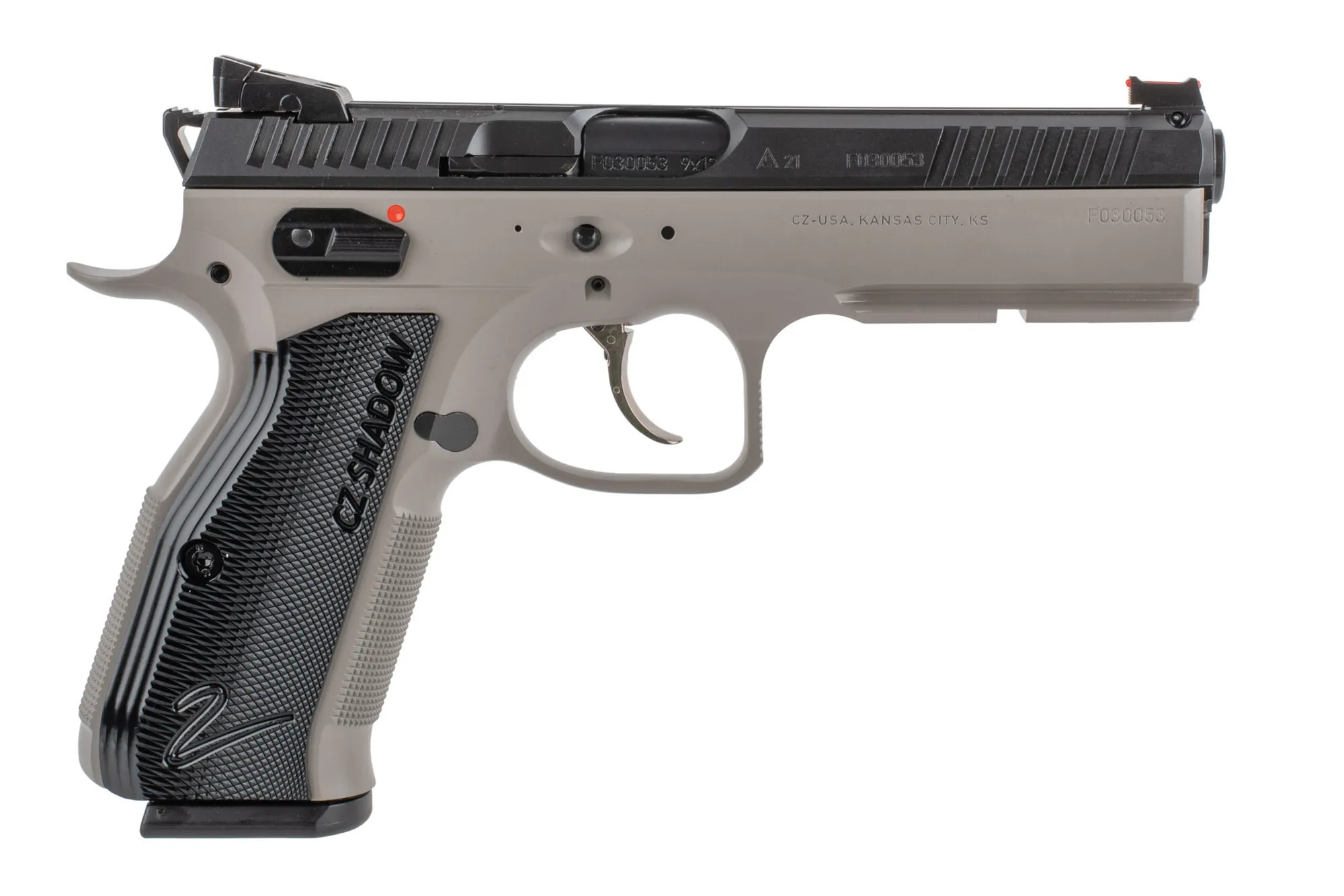
The Shadow 2 is similar in overall dimensions to the Glock 34. The barrel is a bit shorter, at 4.89″, as is the sight radius, but it’s close enough that even excellent marksmen would find little difference. The full-size all-steel frame offers a generous amount of grip, making it suitable for even the largest hands. It’s much more contoured than a Glock, and a fair bit thinner as well, especially with the stock low-profile grip panels. Aggressive checkering on the front and rear backstraps minimize slippage, especially when your hands are slick with sweat or rain.
The Shadow 2 weighs in at a whopping 46.5 ounces, over a pound heavier than the Glock 34. As we mentioned earlier, this weight can be a double-edged sword, but it does mean that the Shadow 2 recoils significantly less. Combined with the high-visibility fiber-optic front sight, this makes for extremely easy sight tracking while firing, even for a novice.
It’s also available in both DA/SA and SAO versions. Single Action Only is our choice for 3-Gun because of the consistent, lightweight trigger, but it largely comes down to personal preference. In either model, the trigger is excellent, one of the best available in a production pistol.
At around $1300, it’s nearly twice as expensive as a stock Glock 34. However, once you account for the cost of any upgrades you may need for the Glock, the price starts to look a whole lot more competitive.
Unfortunately, where the CZ suffers is in the aftermarket. While there are some upgrades available for a crisper trigger or shorter reset, there is not nearly as much customization available as there is for some other firearms. Since the frame is made of steel, there’s not much that can be done with it besides changing out the grip panels; at the end of the day, either you like the way it feels, or you don’t.
The Shadow 2 is particularly well-suited to Tactical or Limited divisions, where optics and compensators are generally prohibited, and magazines are often capped at 140mm. Here, the Shadow 2’s extra weight and low recoil will shine, while polymer guns like the Glock 34 may be more challenging.
If you decide you want to dip your feet into Open or Unlimited division shooting, you may find the Shadow 2 limiting. While optic-ready models and aftermarket optic cuts are available, you’ll have to get creative when mounting a compensator, and it certainly won’t be cheap. In this class, Glock shooters can use compensators and tuned springs to reduce their recoil, minimizing the advantage of the Shadow 2’s weight. Of course, division rules can vary between matches, so it’s worth checking if your local match allows compensators in any division.
Since the Shadow 2 is such a popular competition pistol, there is a good selection of holsters available, many close in price to Glock holsters. Magazines are generally a bit more expensive though. While standard 17-round magazines are comparable in price to Glock mags, to reach the 21-round or 27-round capacity of extended Glock magazines, you’ll need to purchase an aftermarket baseplate in addition to the magazine itself. This can often add up to $50 a magazine by the time it’s all said and done.
For those who want a competitive pistol out of the box or simply don’t want to tinker with their gun, the CZ Shadow 2 is an excellent choice. Its low recoil makes it easy to run fast, and the aftermarket is strong enough that you won’t have any trouble finding a holster or magazines. If you plan on sticking to limited or tactical divisions, you really can’t go wrong with a Shadow 2. Still, it’s a larger up-front investment than a Glock, though not as expensive as the next gun on our list.
IS The Staccato XL At The Point Of Diminishing Returns?
It’s impossible to talk about competitive shooting without discussing the 2011.
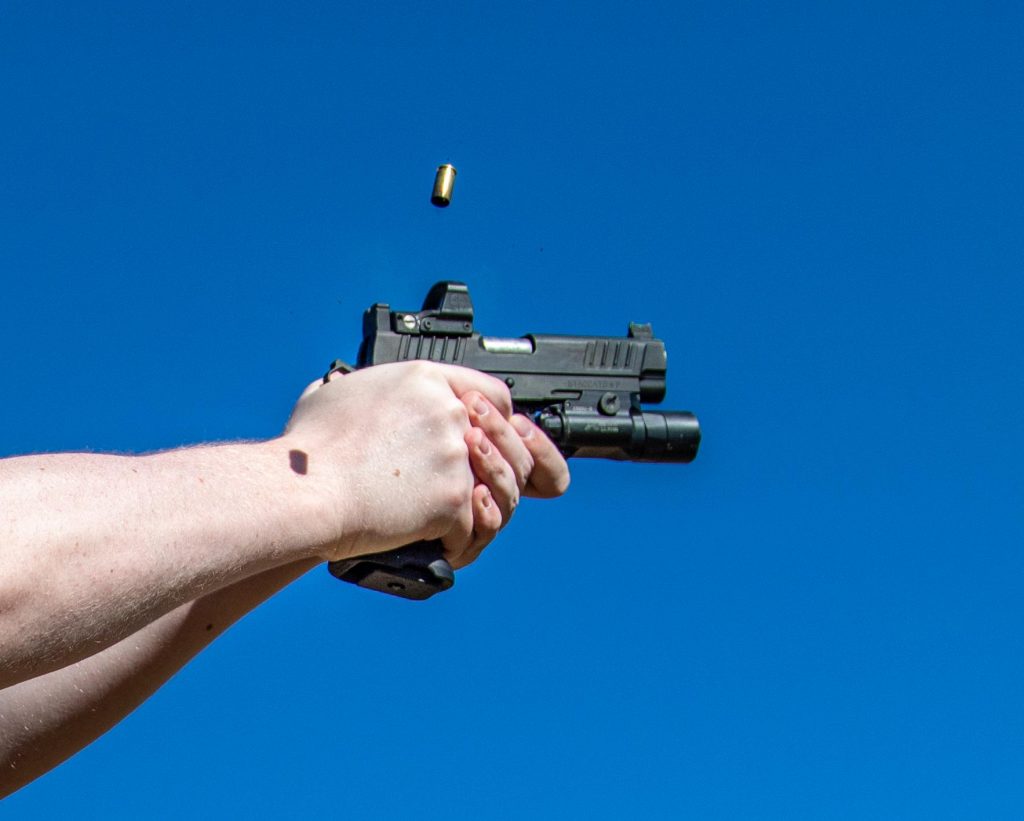
We chose the Staccato XL, but really, this could be any quality 2011. At $3399, the Staccato XL is one of the more economical competition 2011s; custom models can often top $6,000. It’s a tough-to-swallow price tag, but the 2011 platform offers a plethora of advantages other handguns simply can’t match.
2011s tend to push everything to the extreme. The XL has the longest barrel out of any of the guns on our list at 5.4″. It also has the lightest trigger at just 2.5 pounds, which is further enhanced by the straight-pull design. Having the trigger travel directly backward rather than pivot around an axis helps to minimize wobble during the trigger press. While it’s not the heaviest gun on our list, weighing in at 38 ounces, it packs plenty of weight to tame the recoil of a 9mm.
The XL comes out of the box with a fiber optic front and adjustable rear sight, similar to the CZ Shadow 2. The elongated sight radius makes the most of these and lends itself well to accurate shots, even at extended ranges.
It also features a well-textured polymer grip and integrated magwell. Most 2011s are startlingly easy to reload, on account of the highly tapered design of the magazine. With the addition of the magwell, it’s hard to screw up a reload.
The XL itself comes with few options from the factory, but there is a whole host of accessories and upgrades on the aftermarket. Different triggers, grips, sights, safeties: There’s almost no part of this gun that can’t be replaced with a third-party model. As with all things 2011 though, expect to pay a premium.
On the other hand, custom manufacturers such as Atlas offer completely bespoke 2011s. These models can cost twice as much as a Staccato XL, sometimes more, but they offer the end-user complete control over the build. Everything from the magwell to the sights is configurable, often with a mind-boggling number of options.
In some cases, these custom manufacturers can even tune a 2011 for maximum performance with a specific ammunition load, trading versatility for absolute maximum recoil reduction. Such guns are ideal for Open or Unlimited division; they often have red dots mounted to the frame so that they don’t reciprocate during firing, and usually feature a large compensator. You’d be hard-pressed to stretch any firearm to the extremes of performance found in 2011s.
However, excellence comes at a cost, and it’s not just measured in dollar signs. 2011s have a reputation for being finicky, and for good reason. Magazines in particular have been a weak point for the platform; they often cost $100 or more, and even then, require meticulous cleaning and tuning for peak reliability.
Similarly, many 2011s don’t tolerate the same abuses Glocks and CZs will. They operate best when well lubricated and can malfunction if run dry. Maintenance is imperative with these pistols, so users will need to get very comfortable working on their firearm unless they want to have it checked over by a gunsmith every few thousand rounds.
For those willing to put down three grand or more on a pistol, it may be a non-issue, but 2011s suffer from a dearth of options for holsters and accessories compared to our other two recommended firearms. Holsters can be tricky to find even for production models, and if you elect for a custom 2011, you may be forced to commission a custom holster as well. Similarly, many general-purpose mag pouches struggle to retain 2011 magazines due to their aggressive taper.
At the end of the day, 2011s like the Staccato XL are the go-to platform for top competitors for a reason. They require more attention than the other firearms listed here, but for those who want the best possible performance and aren’t afraid to throw down a sizable chunk of change, the 2011 is the obvious choice.
Honorable Mention
While it’s not the best in any category, the Sig Sauer P320 Legion X5 deserves a mention. It’s not the heaviest or the lightest, not the cheapest or the most expensive, but its jack-of-all-trades nature makes it a solid choice.
At around $1000, the X5 sits somewhere between Glock and CZ in terms of price. It comes with a fiber optic front sight out of the box, like the Shadow 2, but uses a striker-fired action like the Glock. The trigger isn’t quite as nice as the CZ or a well-tuned aftermarket Glock trigger, but it’s certainly serviceable.
It also includes a removable magwell for faster reloads. It’s a polymer-framed pistol but features tungsten inserts to bring the weight in line with steel-framed guns.
Sigs P320 series does have a robust aftermarket, but most of it is geared more towards standard P320s rather than the X5. Still, there’s enough out there that users typically have at least a few choices when looking for upgrades.
Being a Sig Sauer, magazines aren’t exactly cheap, but they aren’t as expensive as 2011 mags either. Factory 21-round magazines are available though, so you won’t have to rely on aftermarket baseplates.
If you like striker-fired guns but are looking for a more out-of-the-box solution than a Glock, a Legion X5 might be a good option, especially if you already own other P320s.
Wrap Up
There you have it; a 3-Gun pistol for every budget and experience level.
For competitors who want a cheaper entry-level pistol or a gun they can customize to their heart’s content, the Glock 34 gets our recommendation.
Not a fan of tinkering? Want to just pick up a pistol and shoot? CZ has you covered with the Shadow 2.
Or, if you’re really getting tired of having money in your bank account and willing to put in the maintenance time, a 2011 will reward you with the best shooting experience of your life.
